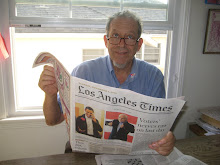MYSTERIOUS, SHIFTING AND ELUSIVE
Mysterious, shifting and elusive,
the Mona Lisa’s smile
is proof that being inconclusive
can help us to beguile
more easily than making clear
the feelings that we hold.
Elusive we, like her, appear
mysterious, yet bold,
but as we shift with sands of time,
we prove by being in-
conclusive there’s no reasoned rhyme
that justifies our grin.
Inspired by James Gardner’s article on the Mona Lisa in the Masterpiece section of the WSJ, May 30, 2009:
The response of most tourists, on first seeing the Mona Lisa in person, is one of vague disappointment. Eavesdrop on the multitudes and, before long, someone will dare to ask the question on everyone’s mind: What’s the big deal? Why has this one painting (probably depicting Lisa Gherardini, the wife of Francesco del Giocondo, a wealthy Florentine silk merchant) come to assume a unique and paramount stature in human culture? A number of factors have supplied it with the necessary mythic updraft. If the Mona Lisa were hanging in the Prado in Madrid or the Kunsthistorisches Museum in Vienna, it would never have achieved the cosmic ranking that it now enjoys. Surely its qualities would be devoutly appreciated, but after the fashion and to the same degree as, say, Leonardo’s “Lady With an Ermine” in the Czartoryski Museum in Krakow. Mona Lisa, however, sits enthroned in the center of the Louvre, which lies in the center of Paris, which, for more than 100 years, was the unchallenged center of Western art. Indeed, the painting, begun in 1503, seemed—and still seems—somehow French, having entered the national patrimony around 1516, when Francis I invited Leonardo to his palace at Amboise. But, of course, the influence of Paris—and its art critics—was only one factor. It was also crucial that Leonardo was a man unlike any other in the history of art. A myriad-minded polymath and inventor, he acquired, even in his own lifetime, the aura of a magus. His entire oeuvre took on a shimmer of holiness that would have made little sense in connection to the mere excellence of, say, Titian or Raphael.And then there is, obviously, the fact that the Mona Lisa is, technically speaking, a very great work of art. But is that really obvious? Well, it would be if we could still see the thing. Unfortunately, like the dollar bill and the American flag, it has assumed a pall of such impenetrable familiarity that we no longer see it at all.But if ever you succeed in seeing the painting as people saw it in centuries past, you will discover something astounding: The Mona Lisa looks entirely different from what we have been led to believe. To many observers, this is the one supreme masterpiece, the unarguable bedrock of our visual culture, the painterly equivalent of the Parthenon, Chartres and the Taj Mahal. In fact, it is anything but that. It is a mysterious, shifting, elusive thing, and it was that very ambiguity that so confounded and compelled the attention of all who saw it in the past.
Linda’s version:
MYSTERIOUS, SHIFTING AND ELUSIVE
THAT MONA LISA’S SMILE
MYSTERIOUS, SHIFTING AND ELUSIVE,
IS PROOF THAT BEING INCONCLUSIVE
WILL ANNUALLY BEGUILE
THE FEELINGS THAT WE HOLD
SO CLOSE, AND NEVER FOCUSSED CLEAR.
ELUSIVE LIKE HER, WE APPEAR
MYSTERIOUS YET BOLD.
I PROVE BY BEING IN-
CONCLUSIVE, SANDS OF SLIPPING TIME
THAT SHIFT AND MORPH LIKE SENSELESS RHYME
SHE JUSTIFIES HER GRIN
© 2009 Gershon Hepner 5/31/09
Tuesday, June 2, 2009
Subscribe to:
Post Comments (Atom)


No comments:
Post a Comment